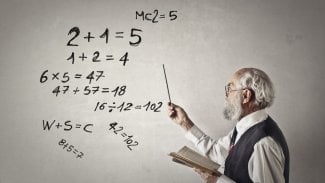ztrevc
NAME
ZTREVC - compute some or all of the right and/or left eigenvectors of a complex upper triangular matrix T
SYNOPSIS
SUBROUTINE ZTREVC(
SIDE, HOWMNY, SELECT, N, T, LDT, VL, LDVL, VR,
LDVR, MM, M, WORK, RWORK, INFO )
CHARACTER
HOWMNY, SIDE
INTEGER
INFO, LDT, LDVL, LDVR, M, MM, N
LOGICAL
SELECT( * )
DOUBLE
PRECISION RWORK( * )
COMPLEX*16
T( LDT, * ), VL( LDVL, * ), VR( LDVR, * ),
WORK( * )
PURPOSE
ZTREVC computes some or all of the right and/or left eigenvectors of a complex upper triangular matrix T.
The right eigenvector x and the left eigenvector y of T corresponding
to an eigenvalue w are defined by:
T*x = w*x, y'*T = w*y'
where y' denotes the conjugate transpose of the vector y. If all eigenvectors are requested, the routine may either return the matrices X and/or Y of right or left eigenvectors of T, or the products Q*X and/or Q*Y, where Q is an input unitary
matrix. If T was obtained from the Schur factorization of an original matrix A = Q*T*Q', then Q*X and Q*Y are the matrices of right or left eigenvectors of A.
T*x = w*x, y'*T = w*y'
where y' denotes the conjugate transpose of the vector y. If all eigenvectors are requested, the routine may either return the matrices X and/or Y of right or left eigenvectors of T, or the products Q*X and/or Q*Y, where Q is an input unitary
matrix. If T was obtained from the Schur factorization of an original matrix A = Q*T*Q', then Q*X and Q*Y are the matrices of right or left eigenvectors of A.
ARGUMENTS
SIDE (input) CHARACTER*1
= 'R': compute right eigenvectors only;
= 'L': compute left eigenvectors only;
= 'B': compute both right and left eigenvectors.
= 'L': compute left eigenvectors only;
= 'B': compute both right and left eigenvectors.
HOWMNY (input) CHARACTER*1
= 'A': compute all right and/or left eigenvectors;
= 'B': compute all right and/or left eigenvectors, and backtransform them using the input matrices supplied in VR and/or VL; = 'S': compute selected right and/or left eigenvectors, specified by the logical array SELECT.
= 'A': compute all right and/or left eigenvectors;
= 'B': compute all right and/or left eigenvectors, and backtransform them using the input matrices supplied in VR and/or VL; = 'S': compute selected right and/or left eigenvectors, specified by the logical array SELECT.
SELECT (input) LOGICAL array, dimension (N)
If HOWMNY = 'S', SELECT specifies the eigenvectors to be
computed.
If HOWMNY = 'A' or 'B', SELECT is not referenced.
To select the eigenvector corresponding to the j-th
eigenvalue, SELECT(j) must be set to .TRUE..
N (input) INTEGER
The order of the matrix T. N >= 0.
T (input/output) COMPLEX*16 array, dimension (LDT,N)
The upper triangular matrix T. T is modified, but restored
on exit.
LDT (input) INTEGER
The leading dimension of the array T. LDT >= max(1,N).
VL (input/output) COMPLEX*16 array, dimension (LDVL,MM)
On entry, if SIDE = 'L' or 'B' and HOWMNY = 'B', VL must
contain an N-by-N matrix Q (usually the unitary matrix Q of
Schur vectors returned by ZHSEQR).
On exit, if SIDE = 'L' or 'B', VL contains:
if HOWMNY = 'A', the matrix Y of left eigenvectors of T;
VL is lower triangular. The i-th column
VL(i) of VL is the eigenvector corresponding
to T(i,i).
if HOWMNY = 'B', the matrix Q*Y;
if HOWMNY = 'S', the left eigenvectors of T specified by
SELECT, stored consecutively in the columns
of VL, in the same order as their
eigenvalues.
If SIDE = 'R', VL is not referenced.
LDVL (input) INTEGER
The leading dimension of the array VL. LDVL >= max(1,N) if
SIDE = 'L' or 'B'; LDVL >= 1 otherwise.
VR (input/output) COMPLEX*16 array, dimension (LDVR,MM)
On entry, if SIDE = 'R' or 'B' and HOWMNY = 'B', VR must
contain an N-by-N matrix Q (usually the unitary matrix Q of
Schur vectors returned by ZHSEQR).
On exit, if SIDE = 'R' or 'B', VR contains:
if HOWMNY = 'A', the matrix X of right eigenvectors of T;
VR is upper triangular. The i-th column
VR(i) of VR is the eigenvector corresponding
to T(i,i).
if HOWMNY = 'B', the matrix Q*X;
if HOWMNY = 'S', the right eigenvectors of T specified by
SELECT, stored consecutively in the columns
of VR, in the same order as their
eigenvalues.
If SIDE = 'L', VR is not referenced.
LDVR (input) INTEGER
The leading dimension of the array VR. LDVR >= max(1,N) if
SIDE = 'R' or 'B'; LDVR >= 1 otherwise.
MM (input) INTEGER
The number of columns in the arrays VL and/or VR. MM >= M.
M (output) INTEGER
The number of columns in the arrays VL and/or VR actually
used to store the eigenvectors. If HOWMNY = 'A' or 'B', M
is set to N. Each selected eigenvector occupies one
column.
WORK (workspace) COMPLEX*16 array, dimension (2*N)
RWORK (workspace) DOUBLE PRECISION array, dimension (N)
INFO (output) INTEGER
= 0: successful exit
< 0: if INFO = -i, the i-th argument had an illegal value
< 0: if INFO = -i, the i-th argument had an illegal value
FURTHER DETAILS
The algorithm used in this program is basically backward (forward)
substitution, with scaling to make the the code robust against
possible overflow.
Each eigenvector is normalized so that the element of largest magnitude has magnitude 1; here the magnitude of a complex number (x,y) is taken to be |x| + |y|.
Each eigenvector is normalized so that the element of largest magnitude has magnitude 1; here the magnitude of a complex number (x,y) is taken to be |x| + |y|.



















